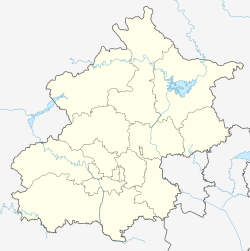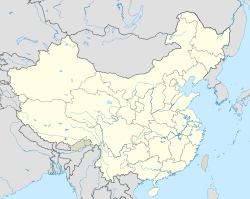Zhangfang Town (simplified Chinese: 张坊镇; traditional Chinese: 張坊鎮; pinyin: Zhāngfǎng Zhèn) is a suburban town in the Fangshan District of Beijing.[1] As of the 2020 census, it had a population of 18,299,[2] and had an area of 119.3-square-kilometre (46.1 sq mi).[3] It is located in southwestern Beijing, approximately 80 kilometres (50 mi) southwest of the city center of Beijing.
Zhangfang Town
张坊镇 | |
|---|---|
 Ancient military tunnel at Zhangfang, 2011 | |
| Coordinates: 39°34′32″N 115°42′40″E / 39.57556°N 115.71111°E | |
| Country | China |
| Municipality | Beijing |
| District | Fangshan |
| Village-level Divisions | 15 villages |
| Area | |
• Total | 119.3 km2 (46.1 sq mi) |
| Population (2020) | |
• Total | 18,299 |
| • Density | 150/km2 (400/sq mi) |
| Time zone | UTC+8 (China Standard) |
| Postal code | 102409 |
| Area code | 010 |
The town was historically a crucial military station, and was named Zhangfang (Chinese: 账房; lit. 'Tent House') as a result. Later the name was corrupted to Zhangfang (张坊) of today.[4]
History
edit| Time | Status | Part of |
|---|---|---|
| Qing dynasty | Zhangfangli (张坊里) | Fangshan County (房山县) |
| 1916 - 1949 | 8th District (八区) | |
| 1949 - 1950 | 2nd District (二区) | |
| 1950 - 1954 | Zhangfang Township (张坊乡) | |
| 1954 - 1958 | Divided among 3 townships: Zhangfang (张坊), Qianhekou (千河口) and Dongguanshang (东关上) | |
| 1958 - 1961 | Zhangfang Management Area (张坊管理区), under Changgou People's Commune (长沟人民公社) | Zhoukoudian District (周口店区) |
| 1961 - 1983 | Zhangfang People's Commune (张坊人民公社) | Fangshan County |
| 1983 - 1986 | Zhangfang Township | |
| 1986 - 1989 | Fangshan District (房山区) | |
| 1989–present | Zhangfang Town |
Administrative divisions
editIn the year 2021, the town was divided into 15 villages:[5]
- Dayugou Village (大峪沟村)
- Beibaidai Village (北白岱村)
- Caijiakou Village (蔡家口村)
- Dongguanshang Village (东关上村)
- Sanhezhuang Village (三合庄村)
- Wagou Village (瓦沟村)
- Ganhekou Village (干河口村)
- Mujiakou Village (穆家口村)
- Guangluzhuang Village (广禄庄村)
- Nanbaidai Village (南白岱村)
- Xibaidai Village (西白岱村)
- Shigezhuang Village (史各庄村)
- Zhangfang Village (张坊村)
- Pianshang Village (片上村)
- Xiasi Village (下寺村)
Geography
editJuma River (拒马河), a tributary of the Daqing River (大清河), flows northwest to southeast through the town.
Mountains located adjacent to and visible from the townsite are: Dawajian (大洼尖), Baihujiao (白虎窖), Zhuanghushan (庄户山), and Ma'anshan (马鞍山).
Education
editZhangfang Town has four public primary schools and one middle school.
Economy
editThe local economy is primarily based upon agriculture and tourism.
Persimmon is important to the local economy.
Religion
editYunju Temple is a Buddhist temple in the town, which was originally built during the Northern Qi dynasty (550–570).
Transportation
editThe Beijing–Tongliao railway, from Beijing to Tongliao in the Inner Mongolia Autonomous Region, runs through the town.
Attractions
editThe main attractions are the Zhangfang Shang and Zhou Dynasties Site (张坊商周遗址), Xianxi Cave (仙栖洞), and Jiulong Pond (九龙潭).
Notable people
edit- Guo Shihong (郭士红), revolutionary martyr.
- Guo Yongsheng (郭永生), revolutionary martyr.
See also
editReferences
edit- ^ 北京房山张坊镇全力打造生态运动小镇. people.com.cn (in Chinese). 2017-09-09.
- ^ "北京市房山区第七次全国人口普查公报". Beijing Fangshan Bureau Of Statistics. Retrieved 2022-10-09.
- ^ 张坊镇基本情况介绍. bjfsh.gov.cn (in Chinese). 2017.
- ^ a b 李立国; 李万钧; 吴世民, eds. (2013). 中华人民共和国政区大典, 北京市卷. Beijing: 中国社会出版社. ISBN 978-7-5087-4058-4. OCLC 910451741.
- ^ "2021年统计用区划代码和城乡划分代码". www.stats.gov.cn. Retrieved 2022-10-10.
External links
edit- Official website (in Chinese)

